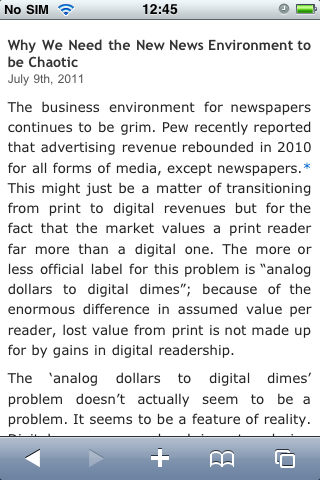The higher the standing of the elite Web commentator, the more likely he (sic) is to avoid, misuse, or distrust the fundamental feature of the Web, the hyperlink.
Clay Shirky’s homepage has real links, but his blog, which uses a default WordPress template with no customization, now deploys what is surely a perversion many times over – asterisks at the end of any sentence that contains a link.
-
Hyperlinks aren’t footnotes. Footnotes don’t exist in HTML.
-
Is the sentence the link text? What happens if you need to link to more than one item in a sentence?
-
Absent a surrounding context like a table row, you can’t use the same link text to point to more than one destination. It’s a WCAG violation.
Nick Carr actually backs Shirky up, and muses about how to make links invisible in all contexts involving CSS. (But CSS is too complex for gurus of Carr’s stature; he doesn’t even realize hyperlinks don’t need to be blue or underlined.)
 A Web guru who can’t even be bothered to turn off full justification or write usable slugs suddenly also can’t be bothered to use real hyperlinks. I could go on, but my fundamental question is this: How do these gurus actually use the Web? Do they not use tabbed browsing – opening background tabs by, say, clicking the mouse wheel? Do they never use RSS or Instapaper? Don’t they use a touchscreen device of any kind? (Quick: Find the link in this screenshot, then tap it.)
A Web guru who can’t even be bothered to turn off full justification or write usable slugs suddenly also can’t be bothered to use real hyperlinks. I could go on, but my fundamental question is this: How do these gurus actually use the Web? Do they not use tabbed browsing – opening background tabs by, say, clicking the mouse wheel? Do they never use RSS or Instapaper? Don’t they use a touchscreen device of any kind? (Quick: Find the link in this screenshot, then tap it.)
Are these gurus so confused by the hyperlink, even after nearly two decades’ practice, that they are just baffled when confronted by a few words that actually contain one? Why on earth do they think anyone else is confused and baffled that way? How, again after nearly 20 years, is a screenful of text “interrupted” by hyperlinks? How do they function using the Web if they are constantly being “interrupted”? (Is the answer that they do not really use the Web?)
How exactly are gurus this smart so stupid when it comes to the actual field they work in?
At any rate, these guys actually aren’t really “blogging” in any real sense of the word. Clay Shirky intermittently emits white papers (commonly at one‑ to three-year intervals) that, while replete with solid thinking, are positioning statements for his guru status. The long intervals between emissions are proof of his wisdom. The implication is only a loser blogs every day, or somebody without high-level consulting clients.
Shirky will be teaching undergrad J-school next year. Consistent with industry practice, he will surely spend no time at all teaching Web standards and semantics or anything related to actually constructing a Web page. HTML is for peons, I guess, and Shirky’s students, I predict, will be trained to enter the elite guru class, making NYU J-school an Eton manqué.
Shirky responded to a question on this topic (without top-posting):
The simple answer is: I’m experimenting.
I agree with Carr that there is a tension between link as referent and link as call to action. I’ve seen it, as a reader, and felt it, as a writer.
The first experiment was in 2009, when I wrote the previous long essay on newspapers, and simply removed anything that failed the Google test (if the result you want to show the reader is the Nº 1 result for that word or phrase in Google, don’t link.) That worked well for that essay, but it wasn’t a general-purpose solution.
What I’m looking for now is a way to write an essay that stands on its own, but offers readers the links that fail the Google test, without going all the way to the cognitive tension of standard links. I’ve been thinking about the iPhone problem, and may go back and link the text preceding the * as black/no underline links, but in general, I prefer this style of linking for this style of reading and writing.
Well, nobody else does save for Shirky’s own rarefied class of Web guru.
There is nothing wrong with a sentence that includes hyperlinks. “A sentence that includes hyperlinks” is the backbone of the Web. The Shirky/Carr approach is a problem masquerading as a solution.